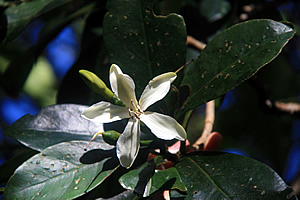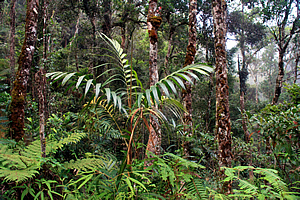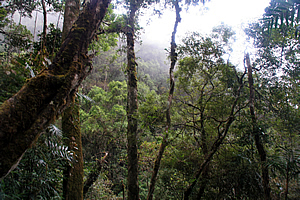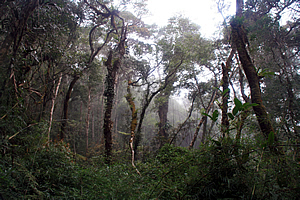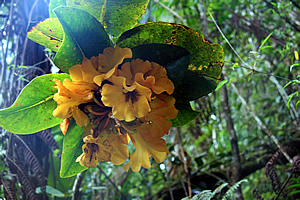--- Archive files ---
Home > Treks > Kinabalu > Day 3 > 3.3 |
Nowhere on Earth more Biodiverse
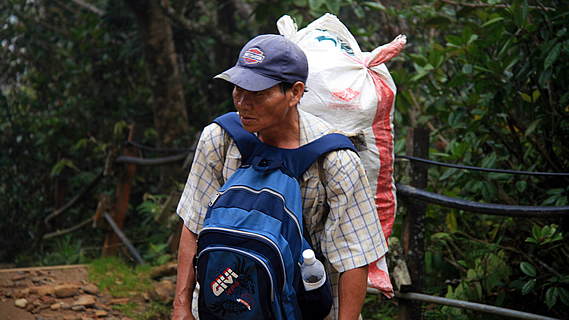
MOUNT Kinabalu is one of the most important biological sites in the world. The mountain has an incredible five to six thousand species of plant, and this doesn’t include countless varieties of mosses or lichen. Within these are over 600 species of fern – 50 are found nowhere else on the planet. There are 800 species of orchid and five of the thirteen known species of Nepenthes carnivorous plant that grow here are found nowhere else on Earth.
Flower |
This incredible biodiversity spanned across three distinct levels of vegetation. Up to 2000 metres above sea level the lower slopes are covered with fig tree cloud forest with many carnivorous plants. Between 2600 and 3200 metres above sea level is a layer of short conifers, mosses, lichens, shrubs and ferns. Above 3200 metres is the world’s richest collection of orchids.
Not only are there many plants, but the animals are spectacular here too. There are 326 species of bird and over a hundred species of mammal on this mountain. There weren’t many visible from the track though. They had strange names like the rhinoceros hornbill, the mountain serpent eagle, dulit frogmouth, eyebrowed jungle flycatcher, bare-headed laughingthrush, and the Bornean spiderhunter, none of which are found anywhere outside the mountain.
Biodiverse cloud forest |
Most of the mammals live high in the trees, including the elusive orang-utan, the man of the forest. They are rarely seen here though. Then there is the endemic Kinabalu giant red leech which preys on the Kinabalu giant earthworm. Those creatures certainly didn’t sound like anything I wanted to encounter.
As we climbed higher and higher through the forest, my tour leader Richard pointed out the amazing plants here, the orchids and nepenthes climbing the trees, the ground toadstools and nepenthes growing in amongst the sphagnum moss, the giant king ferns and countless other species covering the ground. Then I realised there was a strange familiarity to this place. I had seen many of these trees before – or at least very similar species. The trees providing the canopy in the cloud forest here were mostly beech trees similar to those in New Zealand. There were also some European trees and even some tree ferns – Cyathea Cooperii. It was as if New Zealand had combined with Europe, but why did this happen here in Borneo of all places?
Many trees were covered in epiphytes, mostly by various types of orchid growing matted all over them. The species were too numerous to mention here, but they included the rare slipper orchid found only here on the mountain which I had recognised from yesterday. There were numerous other flowering plants that were unfamiliar species to me.
Moss covered trees on the mountainside |
The sky hidden above the thick forest canopy suddenly clouded over. This gave more depth to the eerie forest with the distant trees losing definition in the enveloping fog.
Richard explained to me that this mountain is of a lost world containing a remnant of Gondwanaland. Borneo had been joined to Australia and New Zealand during the days of Gondwanaland up to about a hundred million years ago. When the continents had separated the ancient species went with the continents evolving independently. In most areas around this region they had died out as the earth heated. They remained in the cooler cloud forests of New Zealand and Australia though. They had died out over most of Borneo, but on the steep mountain slopes of Kinabalu, they could just move up and down the mountain as the climate changed between the ice ages and the interglacials.
Remnant of Gondwanaland |
High stable mountains such as this housed lost worlds, and I’m not talking about the small tufts of forest atop each fenglin formation I had seen in Halong Bay that I had imagined last year. This was the real thing. One part of me almost believed there could still be dinosaurs up here, but surely they would have been discovered if that were true.
The lost world we were walking through wasn’t at the top of the mountain as most science fiction would have you believe, but instead it was up the side of the mountain, moving up and down when needed to take into account the natural shifts in climate. So long as the mountain stays here, the vegetation will continue to go up and down the mountain as needed, in what Richard said was the second most bio diverse place on Earth.
|
The most bio diverse place on Earth was the Amazon. That is certainly true with the jungle having a higher number of plant and animal species than even here. That being said though, this was a tiny dot on the map compared to the vast Amazon basin, so I would argue that Mount Kinabalu is by far the most bio diverse place on Earth in terms of the number of species per square kilometre. Thankfully this area was fully protected, not like the Amazon which was experiencing phenomenal levels of deforestation like the lowland jungles of Borneo as I would find out in a couple of days’ time.
Ahead of us was another small sign with a board above it with a map painted on it. It was good to see we were making progress now. This sign read KM2.0 (2252M). We were now higher than any point in Australia. According to the map we were at a place called Ubah.
|
We progressed further into the dense forest continuing our climb fairly quickly up the endless stairway before reaching the next sign. There was no map, but there was an old sign painted in eroded sky blue saying KM2.5 without the altitude almost next to the new sign. I was glad the new signs showed the altitude as that was what really mattered. I didn’t care too much as to how many kilometres we had climbed. What mattered more was what altitude we were at. This sign said KM2.5 (2350M). Now I was higher than Ngauruhoe, and only had a bit further to go before equalling the highest I had ever been. The name of this area was Lowii, named after the first white person to have climbed the mountain and ventured onto the mysterious dome at the top.
|
The going became tough climbing the endless stairway up into the sky, but I remembered what Sapinggi had told us. Pelan pelan, one step at a time. I continued following the track until finally reaching another sign – KM3.0 (2455M). This sign had a map above it. The map showed I was now under the RIM station, a large communications tower, though it was unseen above us through the trees.
The track continued even steeper but I was in a good rhythm now. Nothing was going to hold me back. A bit further up the track I reached the Kempenging shelter at 2518 metres above sea level. There was a fair bit of work that had recently been done there. There was no railing up here to help us up the stairs anymore.
Rhododendron at 2518 metres altitude. |
Just beside the shelter was a magnificent bouquet of yellow rhododendron, the most magnificent I have ever seen. As I stopped to admire the bouquet, I realised this was a significant step for me. It reminded me of the amazing rhododendron gardens growing around Mount Taranaki, the mountain under which I had lived my early childhood. To date this was also the highest mountain I had ever climbed, at 2518 metres, exactly the same altitude I was standing at now. It was very different here though. At the top of Mount Taranaki you are faced with steep volcanic scoria with no vegetation for hundreds of metres below you. You are incredibly exposed up there. Here we were still in the dense cloud forest jungle with a long way to climb to above the bush line.
|
Here I realised if I was to take another step, I would be climbing to new heights. Every step I took from now on will increase the altitude I have ever been. It had actually been quite easy getting up to here despite the eternal set of stairs, so now I started to realise that perhaps I did have what it takes to conquer this mountain.
The climb up the mountain continued, all new territory for me, but still we were in thick cloud forest. Some time later I reached another post saying 3.5KM 2634M with an old sign standing beside the new post.
Here I was about half way up to Laban Rata – actually well over half way in terms of distance, but about half way in altitude, so there was definitely more steep terrain ahead of us to cover as much altitude in less distance. The cloud was now thick and light drizzle was starting to fall. We suddenly reached a couple of small open air huts and stopped there for lunch. We were at Layang Layang. This is the Dusun word for Place of Swallows – not that there were any swallows here today.
|
There was a white hut in front of us which was locked, but it had a large balcony with seats around the outside of it and white tiling on the floor. We sat there and unpacked the lunches that the guides had given us at the bottom of the mountain, now a distant memory far below us. There was also a timber hut across the other side of the track to our right where another group of climbers was eating lunch.
From where we sat, we could see the track rising steeply up a staircase of boulders with timber beams across it to hold it all together. The forest was thinning out from here on as well. There was a warning sign post at the bottom of the stairs in small writing in Malay and English saying “Notice: Climbers proceeding beyond this point without climbing permits and mountain guide will be prosecuted under park enactment 1998. Park Manager.” Obviously from here on it would be too dangerous to go alone. This is where the real climb starts. Will I be able to make it up to Laban Rata?
|
We relaxed as we ate lunch. Although my muscles were feeling numb from the exertion to such high altitude, I was coping well. We sat and ate lunch as numerous small squirrels of an indigenous species (Dundasciurus Tenuis) ferreted in and out of the dense foliage. No doubt the population of squirrels was abnormally high around this area with all the bits of food people drop from their lunches.
As we ate, numerous porters including Bambang and our other porters passed us carrying all kinds of what seemed to be uncomfortable loads on their backs. Some also had loads in front over their chests. They were all men – no women worked as porters on the mountain so it seemed. It was a difficult hike for them, but that was their occupation, the way they earned money to support their families in the villages at the foot of this magnificent mountain of infinite biodiversity.
<< Previous | Next >> |
|
||
About this Page
|
||
|
|
|
Where is Walkabout Jeff? |
|
|
|
|
What is happening in Walkabout Jeff's hometown?
|
|
|
|
|
Who is Walkabout Jeff?Any normal person's idea of going out involves going to the local pub for a drink with a few mates. Walkabout Jeff isn't normal.
|
|
|
|
|
